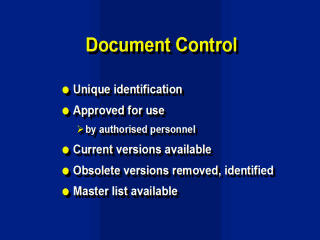| front |1 |2 |3 |4 |5 |6 |7 |8 |9 |10 |11 |12 |13 |14 |15 |16 |17 |18 |19 |20 |21 |22 |23 |24 |25 |26 |27 |28 |29 |30 |31 |32 |33 |34 |35 |review |
 |
Many organisations
have a system of numbering documents.
A QMS document must be uniquely (i.e. unambiguously) identified, but this can sometimes if convenient be done with a name rather than with a number. Immediate removal of obsolete versions of documents, so that they cannot be accidentally used, is integral to document control. One copy is marked obsolete and retained for archiving purposes, the remaining documents are destroyed. An obsolete copy must be kept for historical purposes, it need to be identified as obsolete, e.g. by being stamped "obsolete". This is to guard against accidental use. It is essential, for the historical record, that the contents of obsolete QMS documents are recorded in some way. This can be done through keeping identified hard copies of the obsolete documents, or they can be preserved electronically. An electronic list of changes that have been made may serve, instead of keeping a copy of the whole obsolete document. A controlled document master list must be maintained, in hard copy or electronically. This can be consulted at any time, by staff or auditors, to determine which is the current version of any QMS document. |